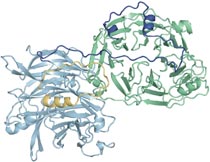
Handy Links
SLAC News Center
SLAC Today
- Subscribe
- Archives: Feb 2006-May 20, 2011
- Archives: May 23, 2011 and later
- Submit Feedback or Story Ideas
- About SLAC Today
SLAC News
Lab News
- Interactions
- Lightsources.org
- ILC NewsLine
- Int'l Science Grid This Week
- Fermilab Today
- Berkeley Lab News
- @brookhaven TODAY
- DOE Pulse
- CERN Courier
- DESY inForm
- US / LHC
SLAC Links
- Emergency
- Safety
- Policy Repository
- Site Entry Form

- Site Maps
- M & O Review
- Computing Status & Calendar
- SLAC Colloquium
- SLACspeak
- SLACspace
- SLAC Logo
- Café Menu
- Flea Market
- Web E-mail
- Marguerite Shuttle
- Discount Commuter Passes
-
Award Reporting Form
- SPIRES
- SciDoc
- Activity Groups
- Library
Stanford
Around the Bay
The Many Sides of Cells
 The mechanics of a basic cellular process found in most living organisms, including humans, is
less of a mystery, thanks to work done in part by Douglas Hattendorf at the Stanford Synchrotron Radiation Laboratory (SSRL). The team of researchers, led by
Bill Weis of the Stanford University School of Medicine, solved the structure of a protein that assists in the developmental process of cellular polarization, which gives cells the ability to perform specific biological functions.
The mechanics of a basic cellular process found in most living organisms, including humans, is
less of a mystery, thanks to work done in part by Douglas Hattendorf at the Stanford Synchrotron Radiation Laboratory (SSRL). The team of researchers, led by
Bill Weis of the Stanford University School of Medicine, solved the structure of a protein that assists in the developmental process of cellular polarization, which gives cells the ability to perform specific biological functions.
Polarization occurs in most living cells, and is a feature whereby different sides of individual cells are made up of membranes of differing composition that perform different functions. Epithelial cells in the lining of the gut, for example, possess membranes that absorb nutrients on one side and membranes that connect to other cells on the other side. Special surface proteins determine the composition and function of these differing membranes. The current study sheds light on how these surface proteins find their way to the proper membrane of a cell.
Within a cell, pockets called vesicles deliver proteins to the various surface membranes, fusing with the membrane to deliver its cargo. The mechanism behind how vesicles discriminate between the membranes—fusing with some but not with others—has been mostly a mystery.
Using SSRL Beamline 11, Hattendorf and colleagues solved the structure of a yeast cell protein key to the process of polarization, called Sro7p, that is also found widely in other organisms. It is known that the Sro7p protein is involved in vesicle–membrane fusion. This protein consists of two barrel shaped structures and an additional, unexpected feature— a “tail” consisting of 60 amino acids that is bound to the bottom surface of one of the barrel s. The researchers found that this tail is responsible for regulating how Sro7p interacts with other proteins that are important for vesicle fusion. It is this property that may give vesicles the ability to preferentially fuse with some membranes and not others, allowing them to deliver proteins to the correct locations on the cell surface to establish cellular polarity.
—Brad Plummer, SLAC Today, July 26, 2007
Above image: Structure of the Sro7p protein involved in cellular polarization.